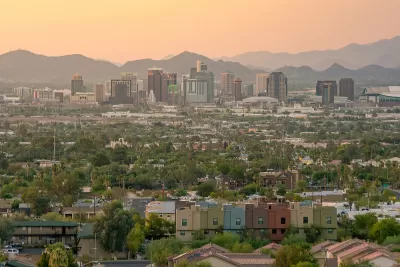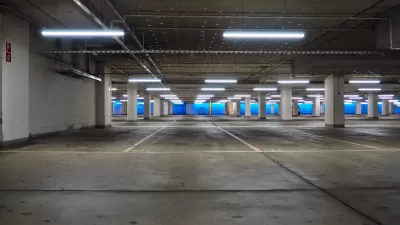In addition to lower citywide parking requirements on residential properties, a proposed law in Phoenix would lower minimum parking requirements even further for affordable housing developments near the city’s light rail system.

Phoenix planners are preparing a new law that would ease parking requirements for residential development around the city as well as transit oriented development near the city’s light rail system, with the Phoenix City Council expected to make a decision on the proposed zoning changes in September.
The proposed changes to the city’s parking requirements “would lower that bottom floor [set by minimum parking requirements] across the city but lower it even further for affordable housing complexes and developments in the Gateway, Eastlake-Garfield, Midtown, Uptown and Solano neighborhoods, which surround light rail,” according to a pawywalled article by Taylor Seely for the Arizona Republic.
“Under the new law, a 100-unit apartment complex in one of those five communities near light rail could see the requirement lower from 113 required spaces to 50 spaces. If it's an affordable complex in one of those communities, the parking quota would, in most cases, fall to zero,” adds Seely. “A 100-unit complex elsewhere in the city would go from 150 spaces to 125 spaces. If it's an affordable complex but not near light rail, it would go from 150 required spaces to 63.”
The source article notes that parking reform is increasingly popular in U.S. cities, listing Minneapolis, Portland, and Austin as examples.
The article lays out the arguments of supporters and opponents of the new law. Seely says residents “by and large” oppose the change, but implies that opponents might not be able to sway members of the Phoenix City Council from supporting the new law.
FULL STORY: Phoenix considers allowing fewer parking spaces for apartments in push for public transit [pawywall]

Trump Administration Could Effectively End Housing Voucher Program
Federal officials are eyeing major cuts to the Section 8 program that helps millions of low-income households pay rent.

Planetizen Federal Action Tracker
A weekly monitor of how Trump’s orders and actions are impacting planners and planning in America.

Ken Jennings Launches Transit Web Series
The Jeopardy champ wants you to ride public transit.

‘Smart Surfaces’ Policy Guide Offers Advice for Building and Maintaining Urban Tree Canopies
Healthy, robust tree canopies can reduce the impacts of extreme heat and improve air quality.

New Jersey Lawsuit Targets Rent-Setting Algorithms
The state of New Jersey is taking legal action against landlords and companies that engage in what the state’s Attorney General alleges is illegal rent fixing.

Washington Legislature Passes Rent Increase Cap
A bill that caps rent increases at 7 percent plus inflation is headed to the governor’s desk.
Urban Design for Planners 1: Software Tools
This six-course series explores essential urban design concepts using open source software and equips planners with the tools they need to participate fully in the urban design process.
Planning for Universal Design
Learn the tools for implementing Universal Design in planning regulations.
Heyer Gruel & Associates PA
Ada County Highway District
Institute for Housing and Urban Development Studies (IHS)
City of Grandview
Harvard GSD Executive Education
Toledo-Lucas County Plan Commissions
Salt Lake City
NYU Wagner Graduate School of Public Service





























